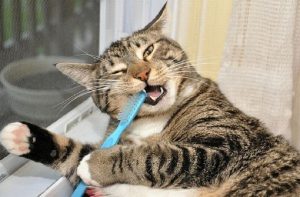Good dental hygiene is just as important for pets as it is for people. If in doubt, imagine how your teeth would look and feel if you didn’t brush them for weeks or even years! Your pet’s teeth are no different. Unless you regularly provide some form of dental care, you’re ignoring a vital part of your pet’s overall health.
Gum (periodontal) disease is by far the most common major dental problem in cats and dogs. According to the American Veterinary Dental Society, by the time they are 3 years old, more than 70% of cats and 80% of dogs show early signs of the disease, which will worsen as the pet grows older if effective preventive measures aren’t taken.

Gum disease starts when bacteria combine with food to form plaque on teeth. Initially, plaque is soft, so brushing or chewing kibble and toys can dislodge it. Plaque soon hardens to form tartar and if ignored can lead to gum inflammation, causing them to be red, swollen and bleed. Tartar above the gum-line can be seen and removed, but tartar below the gum-line is harmful and may lead to infection and damage to the tooth, jawbone and surrounding tissues. This is very painful for your pet, but the good news is that these issues can be prevented before they start with proper dental care.
Gum disease doesn’t just affect your pet’s mouth. Advanced gum disease can have serious impacts on your pet’s heart, kidneys, and liver. Pets are good at hiding pain; you may not know that your pet has a serious problem until it’s very advanced. That’s why it’s crucial to take your pet in for regular dental checkups and professional cleanings. Remember that the adverse effects of dental disease far outweigh any small risk posed by anesthesia.
Regularly brushing your pet’s teeth at home is the most effective thing you can do to keep your pet’s mouth healthy between professional cleanings by your vet. Most dogs accept brushing, while cats can be a bit more resistant, so patience is key. Start out gradually for a minute at a time, using flavored toothpaste specifically made for cats and dogs, treats and lots of praise so your pet comes to have a positive association with brushing. Use a child’s toothbrush or finger brush; never use human toothpaste. The web has many helpful videos about brushing your pet’s teeth. Brushing several times a week is ideal. Don’t try brushing for the first time if your pet’s gums are red or inflamed – visit your vet for an assessment.
Your pet’s teeth should be checked at least once a year by your vet. Visit your vet sooner if you observe any of the following problems:
- bad breath
- teeth that are discolored or covered in tartar
- broken or loose teeth
- difficulty chewing, dropping food from the mouth or drooling
- reduced appetite or refusal to eat
- pawing at the mouth
- pain or swelling in or around the mouth
- bleeding from the mouth.
Always be careful when checking your pet’s mouth, because an animal in pain may bite.
What else can you do to keep your pet’s teeth clean? Aside from regular brushing and professional cleaning, your vet may recommend a plaque prevention product and/or switching to a dental diet designed to improve bad breath and prevent plaque and tartar build-up. Certain treats and toys also promote good oral health.
Good dental care, both at home and at your vet, plays a key role in helping your pet live a longer, healthier life.
Did you know that the Nova Scotia SPCA’s Pet Health Insurance plan includes routine dental coverage and each policy purchased helps support our shelters? To learn more, click here.
